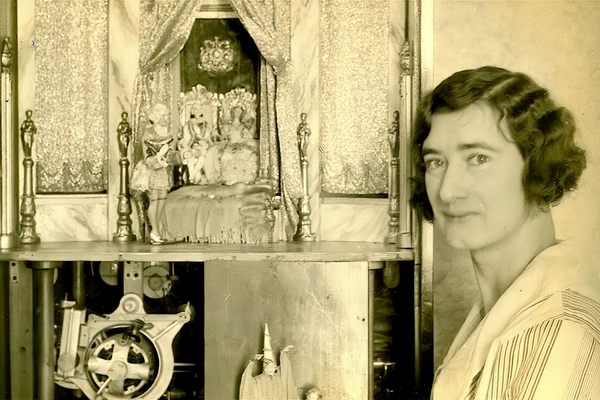Uncovering Edinburgh’s Hidden Victorian History—One Doorway at a Time
A new project delves into the stories of forgotten Edinburgh residents and the places they called home.
On a cool August morning in 2022, Edinburgh resident Diarmid Mogg was out for a walk recovering from a bout of COVID-19. While he strolled along his quiet, residential neighborhood at the edge of the city center, a green door of a Victorian building caught his eye.
The door was grubby, graffitied, and clearly very old, likely built sometime (like so much of Edinburgh) in the early 19th century. “But what was this door’s story?” Mogg wondered. What kind of lives might it have witnessed?
Right there, in front of the eye-catching doorway, Mogg searched the address in the British Newspaper Archive on his phone. Within seconds, he was skimming through stories of past residents. In 1888, a window cleaner had fallen off the building and died. In 1896, a resident died of gangrene after a heavy package fell on his toe at a train station in Dublin, Ireland. In 1916, another resident died in a car accident while driving along a coastal Aberdeen highway.
Mogg was galvanized to research similar historical buildings that were built sometime between 1812 and 1910. As he uncovered the history of more and more buildings, a narrative of Edinburgh began to unfurl, one he shares publicly on his website, Tenement Town, where he posts a photo of each door along with an accompanying text that explores its history. Atlas Obscura spoke to Mogg about a woman who used a flowerpot as a secret code to her lover, the wonders hidden within newspaper archives, and how the project has brought him closer to the city he calls home.

Which doors do you decide to feature on Tenement Town and why?
It’s entirely random. Initially, the ones that caught my eye were the doors that were heavily graffitied but belonged originally to rather nice residences for Edinburgh’s middle class.
Now I look for any interesting doorway. It could be something with a nice pediment or shops beside it. You might have a nice classical doorway with a really ugly tanning salon next to it, that sort of thing.
What’s your process for researching each door?
When a door catches my eye, I go straight to the British Newspaper Archive website and enter the street address. Just glancing at the first few pages of results I get quite a good feel for it.
If it’s mostly just advertisements for rooms to let, there might not be a great story there. But if the door is particularly interesting, I keep scrolling. If I find a meaty news item, I use it as the anchor for all the other stories in the stair [a Scottish term for tenement building].
Then I cross-reference not only the person in the news item, but everyone related to that person, with census records, ancestry websites, birth and death certificates, to make sure I have got the right people. Basically, I follow every single possibility that comes off the name.
I search until I have run out of the road. It’s like pulling a thread. Some threads are short, some long. And as they unravel, you get the whole story.

What has surprised you the most as you’ve done this project?
Behind almost every tenement door there are a host of interesting stories. Some remarkable lives have been lived in almost complete obscurity.
People mentioned once in a newspaper story were forgotten when that paper was thrown in the bin at the end of the day. But the thing that they were mentioned for once is, in retrospect, quite astonishing.
Some stories are like big Victorian romance novels. There was a woman called Jane Anne Walker in the 1870s, who was clearly bored in her marriage. She had a long affair with a novelist called James Grant. I found a secret letter she wrote to her lover: “How miserable I feel! Not even one of your clear, sunny looks I have had.” Eventually, her husband divorced her, and she died in shame and ignominy, which is what usually happened to women in these divorce stories.
Then there was a woman called Helen Pairman, who was having an affair with her doctor. Neighbors noticed that he would arrive every time a flowerpot appeared at her window—code that her husband was away. He always came wearing his top hat and beneath it there was a bunch of flowers.
What I love is when I pass this door, which I do a lot because it’s near me, I always think that is the door through which a Victorian doctor passed with a bunch of flowers hidden under his top hat.
What kind of characters are you drawn to?
I am interested in unknown people because they feel more like me. I am an unknown, normal person. I am not special or famous in any way.
I focus on people who have been written about a little at the time and nobody has touched their story since. So these stories are a little like gold in a riverbed.

What have you learned about life in Victorian Edinburgh?
The times were hard. The lives of ordinary people who lived in these tenements were defined by child death, tuberculosis, and hard work. People died in their homes, not in hospitals. Not a lot of people who currently live in these buildings give a thought to the fact that dozens of people have lived and died in the homes they occupy.
The lack of freedom that women had compared to men is striking through all these stories. Women were monitored by their husbands, their doctors, their servants. The whole structure was there to control them. And the men, in a lot of the stories that I’ve come across, behaved in disgraceful ways towards them and by and large got off without any repercussions whatsoever.
Has your relationship with the city changed since you started doing this project?
Now when I walk past buildings I’ve researched, I feel a friendly connection with them that I didn’t have before. It is very good for the soul. I love when it’s possible to see or touch something that is connected to the story.
Do you see yourself as a historian?
I see myself as a storyteller of history. I try and give people an impression of what it might have been like to be alive at a particular point in history.
This interview has been edited for length and clarity.



























Follow us on Twitter to get the latest on the world's hidden wonders.
Like us on Facebook to get the latest on the world's hidden wonders.
Follow us on Twitter Like us on Facebook